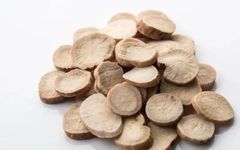Disease Inquiry, Health Guidance, Classic Health Preservation, Traditional Chinese Medicine and Herbs, Seeking Help for Illness
Bai Shao (白芍) is commonly found in TCM prescriptions, primarily used in its raw form, hence also known as Sheng Bai Shao (生白芍). So, what are the efficacy and functions of Bai Shao? Let’s explore this together!
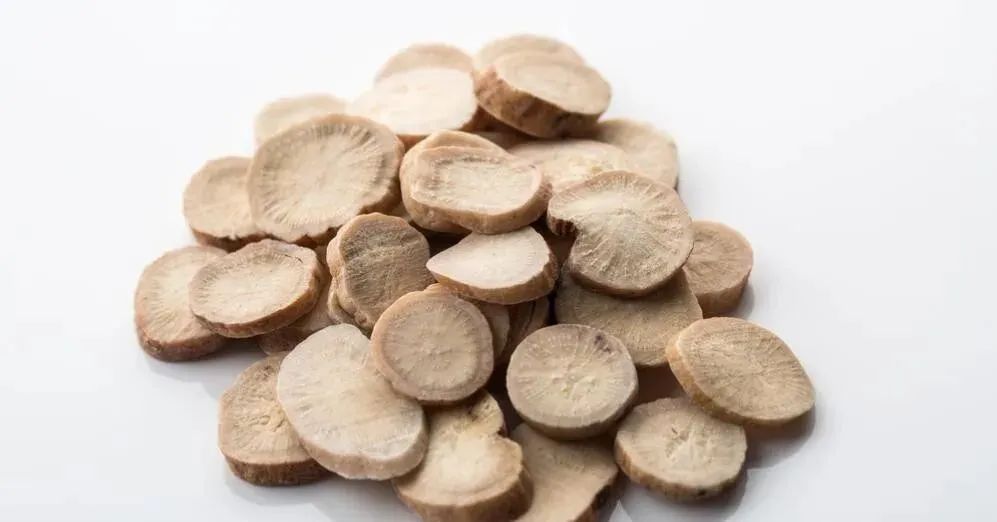 Bai Shao is also known as Bai Shao Yao (白芍药) and Jin Shao Yao (金芍药).
Bai Shao is also known as Bai Shao Yao (白芍药) and Jin Shao Yao (金芍药).
The plant is a perennial herb, growing 50-80 cm tall. The roots are thick, usually cylindrical or slightly spindle-shaped. The stems are erect and smooth without hairs. The leaves are alternate; with long petioles; 2-3 times compound leaves, with leaflets that are oval to lanceolate, 8-12 cm long and 2-4 cm wide, with a gradually pointed or sharp tip, wedge-shaped base, entire margin, and very fine papillae on the leaf edge. The upper side is dark green, while the underside is light green, with prominent veins on the underside. The base of the leaves often has a reddish tint. The flowers are very large, solitary at the top of the flower stem, with 2-5 flowers per stem, which is 9-11 cm long; there are 3 sepals, leaf-like; about 10 or more petals, ovate, white, pink, or red; numerous stamens with yellow anthers; 3-5 carpels, separate. The fruit is a follicle with 3-5 pieces, oval, with a hooked tip bending outward. The flowering period is from May to July, and the fruiting period is from June to July. The source is the root of the cultivated species of the Ranunculaceae family, Peony (芍药). The roots are harvested in summer and autumn after 3-4 years of planting, removing the rhizome and fibrous roots, washing clean, scraping off the rough skin, and briefly boiling in water to soften the roots before drying.
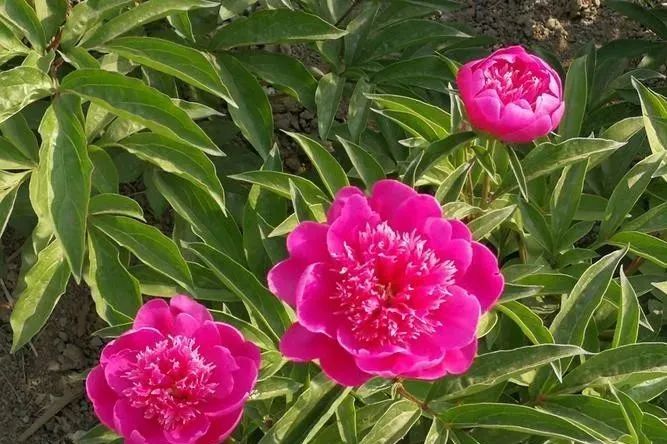 Meridian Affinity: Liver (肝); Spleen (脾)
Meridian Affinity: Liver (肝); Spleen (脾)
Taste and Properties: Bitter (苦); Sour (酸); Slightly Cold (微寒)
Precautions: Not suitable for use alone in cases of deficiency-cold syndrome. Antagonistic with Li Lu (反藜芦).
Main Functions and Indications: Nourishes Blood and Yin; alleviates pain; calms the liver. Indicated for irregular menstruation; abdominal pain during menstruation; metrorrhagia; spontaneous sweating; night sweats; pain in the hypochondrium and abdomen; limb cramps; headaches; dizziness.
Dosage: For internal use: decoction, 5-12 g; or in pills or powders. Large doses can be used at 15-30 g.
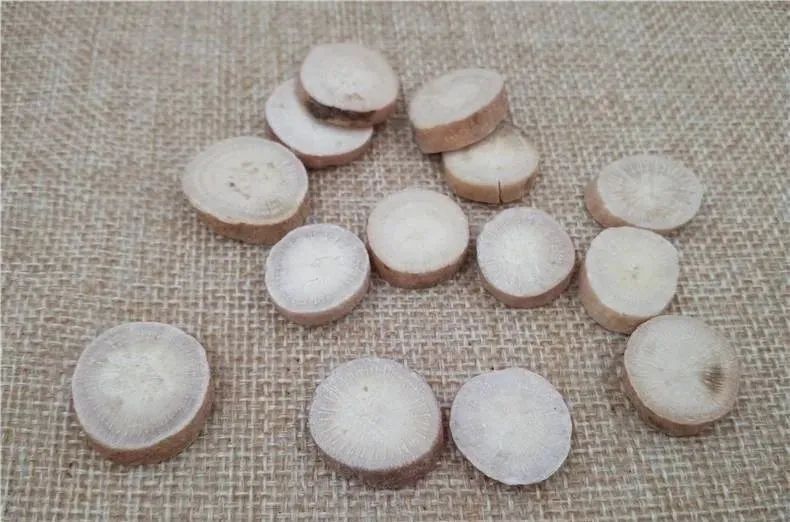 Efficacy and Functions of Bai Shao
Efficacy and Functions of Bai Shao
1. Bai Shao can treat cardiovascular diseases.
Bai Shao can dilate human coronary arteries, regulate blood pressure and blood lipids, and reduce platelet aggregation, significantly preventing thrombosis, thus playing a role in treating cardiovascular diseases.
2. Bai Shao can regulate the immune system.
Bai Shao has a significant effect on enhancing the immune system; it not only protects the liver but also regulates gastric juice secretion, ensuring that all internal organs function normally, thereby increasing the body’s resistance to diseases and significantly improving immune function.
3. Bai Shao has analgesic and sedative effects.
Analgesia and sedation are also important functions of Bai Shao. It contains certain saponins that, upon entering the body, can regulate the nervous system, alleviate pain symptoms, and relieve anxiety, preventing negative emotions such as panic and tension.
4. Bai Shao also nourishes and replenishes blood.
The blood-nourishing and replenishing effects of Bai Shao are remarkable, and it can be used to treat various adverse symptoms such as excessive menstrual bleeding or postpartum hemorrhage. Additionally, Bai Shao has a protective effect on the liver, reducing viral damage to the liver.
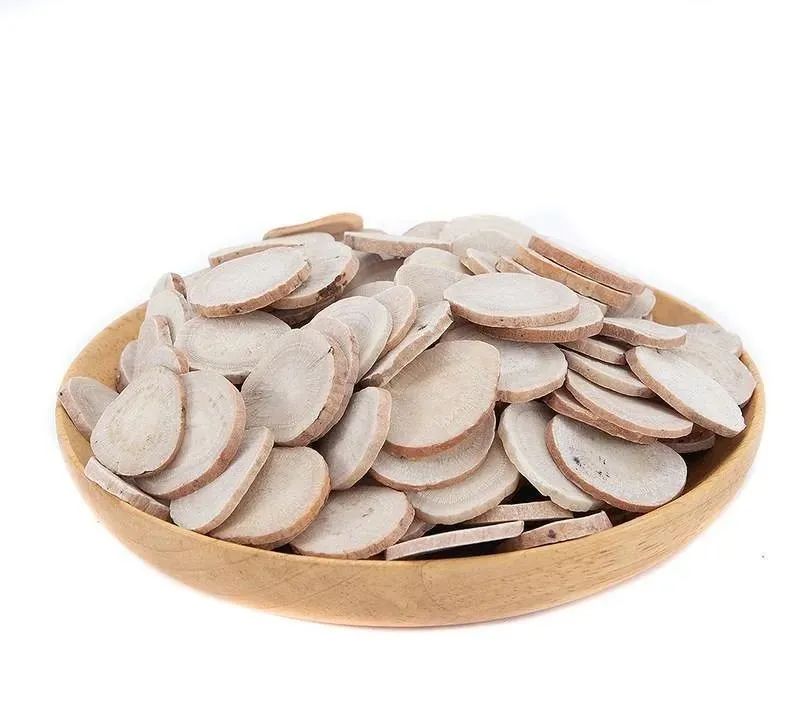 Selected Formulas
Selected Formulas
① For treating women’s hypochondriac pain: Xiang Fu Zi (香附子) 4 liang, Huang Zi Cu (黄子醋) 2 bowls, salt 1 liang, boil until dry, plus Rou Gui (肉桂), Yan Hu Suo (延胡索, stir-fried), Bai Shao Yao (白芍药). Grind into a fine powder, take 2 qian each time, decoct in boiling water, take at any time. (From Zhu’s Collection of Verified Medical Formulas – Bai Shao Decoction)
② For treating dysentery with pus and blood, urgency, and heaviness: Bai Shao 1 liang, Dang Gui (当归) 0.5 liang, Huang Lian (黄连) 0.5 liang, Bing Lang (槟榔), Mu Xiang (木香) 2 qian; Gan Cao (甘草) 2 qian (stir-fried), Da Huang (大黄) 3 qian, Huang Qin (黄芩) 0.5 liang, Guan Gui (官桂) 2.5 qian. Finely chop, take 0.5 liang each time, boil in 2 cups of water until reduced to 1 cup, take warm after meals. (From Suwen on Disease Mechanisms and Life Preservation – Bai Shao Decoction)
③ For treating abdominal pain during pregnancy: Dang Gui 3 liang, Bai Shao 1 jin, Fu Ling (茯苓) 4 liang, Bai Zhu (白术) 4 liang, Ze Xie (泽泻) 0.5 jin, Chuan Xiong (川芎) 0.5 jin (or 3 liang). Grind these six ingredients into a powder. Take a small spoonful mixed with wine, three times a day. (From Jin Gui Yao Lue – Dang Gui Bai Shao Powder)
④ For treating postpartum abdominal pain due to blood stasis: Bai Shao 2 liang, Gui (桂, peeled), Gan Cao (甘草, roasted) each 1 liang. Grind these three ingredients, take 3 qian each time, boil in 1 cup of water, simmer until 7 parts remain, strain, and take warm, without time restrictions. (From Sheng Ji Zong Lu – Bai Shao Decoction)
⑤ For treating dysmenorrhea: Bai Shao 2 liang, Gan Jiang (干姜) 8 qian. Grind into a fine powder, divide into eight packets, take one packet daily during menstruation, with yellow wine as a guide, for three consecutive weeks. (From Inner Mongolia – Selected Materials on New Medical Methods of Chinese Herbal Medicine)
⑥ For treating chronic leucorrhea: Bai Shao Yao 3.5 liang, Gan Jiang 0.5 liang. Finely chop, fry until yellow, pound and sift. Take 2 qian each time on an empty stomach, twice a day. (From Guang Li Fang)
⑦ For treating bleeding from wounds: Bai Shao Yao 1 liang, fry until yellow, pound finely into a powder. Take 2 qian with wine or rice wine, gradually increasing. (From Guang Li Fang)
⑧ For treating edema and pain in the feet: Bai Shao Yao 6 liang, Gan Cao 1 liang. Grind into a powder, take with white soup. (From Seasonal Records)
To learn more about Traditional Chinese Medicine, Chinese herbs, herbal formulas, and folk remedies, ▼ click the card below ▼ to inquire!
For example: back pain, gynecology, andrology, kidney tonification, lumbar disc herniation, back pain, leg pain, knee pain, cervical spondylosis, liver disease, stomach disease, constipation, frequent urination, diarrhea, abdominal protrusion, dysmenorrhea, breast hyperplasia, breast cancer, postpartum care, acne, white hair, hair loss, breast enhancement, beauty, skin diseases, age spots, aging, yin deficiency, cold, cough, fever, insomnia, stones, pharyngitis, sore throat, headache, toothache, snoring, oral ulcers, bad breath, rhinitis, tinnitus, eye diseases, thyroid issues, dandruff, athlete's foot, hemorrhoids, cold hands and feet, rheumatism, night sweats, cancer, cerebral hemorrhage, hypertension, diabetes, asthma, heart disease, cardiovascular diseases, fatty liver, gout, dementia, varicose veins, qi tonification, blood tonification, calcium supplementation, weakness, obesity, pediatric diseases, slim legs, slim waist, dampness, spleen strengthening, hiccups, body odor, cramps, smoking cessation, meridians, Chinese patent medicines, foot baths... and more.
Thank you for sharing and clicking 'like' for continuous good fortune.

